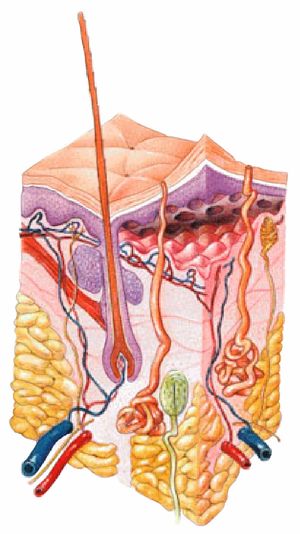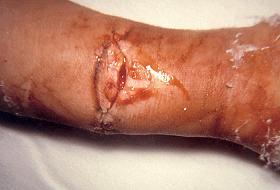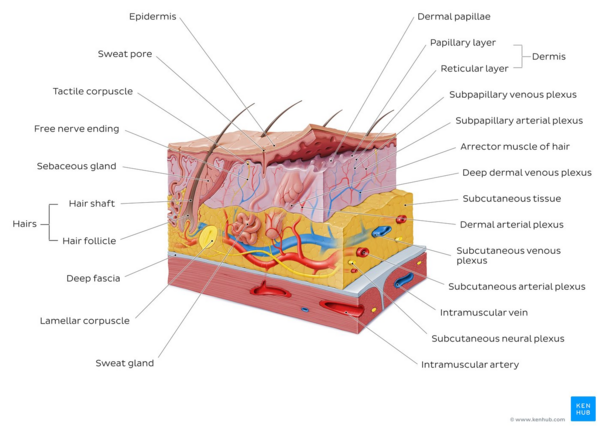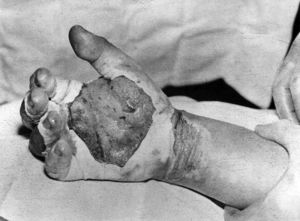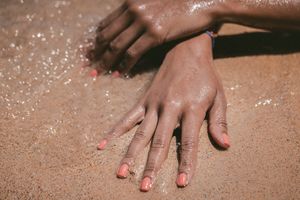Integumentary System: Difference between revisions
No edit summary |
Joao Costa (talk | contribs) No edit summary |
||
| (12 intermediate revisions by 4 users not shown) | |||
| Line 9: | Line 9: | ||
The integumentary system includes | The integumentary system includes | ||
* Skin (epidermis, dermis) | * [[Skin]] (epidermis, dermis) | ||
* Hypodermis | * Hypodermis | ||
* Associated glands | * Associated [[Metabolic and Endocrine Disorders|glands]] | ||
* Hair | * Hair | ||
* Nails. | * Nails. | ||
In addition to its barrier function, this system performs many intricate functions such as body temperature regulation, cell fluid maintenance, synthesis of [[Vitamin D Deficiency|Vitamin D]], and detection of stimuli. The various components of this system work in conjunction to carry out these functions<ref name=":0">Kim JY, Dao H. [https://www.ncbi.nlm.nih.gov/books/NBK554386/ Physiology, Integument]. InStatPearls [Internet] 2020 Feb 17. StatPearls Publishing.Available from:https://www.ncbi.nlm.nih.gov/books/NBK554386/ (last accessed 23.10.2020)</ref>. | In addition to its barrier function, this system performs many intricate functions such as body temperature regulation, cell fluid maintenance, synthesis of [[Vitamin D Deficiency|Vitamin D]], and detection of stimuli. The various components of this system work in conjunction to carry out these functions<ref name=":0">Kim JY, Dao H. [https://www.ncbi.nlm.nih.gov/books/NBK554386/ Physiology, Integument]. InStatPearls [Internet] 2020 Feb 17. StatPearls Publishing.Available from:https://www.ncbi.nlm.nih.gov/books/NBK554386/ (last accessed 23.10.2020)</ref>. | ||
== General Function == | |||
The integumentary system has several functions that provide several purposes<ref name="one">Martini FH, Nath, JL. Fundamentals of Anatomy and Physiology. 8th ed. Pearson. San Francisco: Benjamin Cummings. 2009</ref>: [[File:Wound botulism.jpg|right|frameless]] | |||
* Physical protection: The integumentary is the covering of the human body and its' most apparent function is physical protection: skin - a tightly knit network of cells, with each layer contributing to its strength. The epidermis has an outermost layer created by layers of dead keratin that can withstand wear and tear of the outer environment, the dermis provides the epidermis with [[blood]] supply and has [[Neurone|nerves]] that bring danger to attention amongst other functions; hypodermis provides physical cushioning to any mechanical trauma through adipose storage; glands secrete protective films throughout the body; nails protect the digits; hairs throughout the body filter harmful particles from entering the eyes, ears, nose, etc. | |||
[[ | |||
* | *[[Immune System|Immunity]]: The skin is the body’s first line of defense acting as a physical barrier preventing direct entry of pathogens. Antimicrobial peptides (AMPs) and lipids on the skin also act as a biomolecular barrier that disrupts [[Bacterial Infections|bacterial]] membranes. Resident immune cells, both [[Leukocytes|myeloid]] and [[Lymphatic System|lymphoid]] cells are present in the skin, and some, eg Langerhans cells or dermal dendritic cells, can travel to the periphery and activate the greater [[Immune System|immune system]]<ref name=":0" /> | ||
*[[Wound Healing|Wound healing]]: When our body undergoes trauma with a resulting injury, the integumentary system orchestrates the wound healing process through hemostasis, inflammation, proliferation, and remodeling.<ref name=":0" /><ref name=":0" /> | |||
* | *Thermoregulation: The skin has a large surface area that is highly vascularized, which allows it to conserve and release heat through vasoconstriction and vasodilation, respectively<ref name=":0" />. | ||
*Thermoregulation: The skin has a large surface area that is highly vascularized, which allows it to conserve and release heat through vasoconstriction and vasodilation, respectively<ref name=":0" />. | *Vitamin D synthesis: The primary sources of vitamin D are sun exposure and oral intake (crucial for bone health)<ref name=":0" />. | ||
*Vitamin D synthesis: The primary sources of vitamin D are sun exposure and oral intake | |||
*Sensation- Skin innervation is by various types of sensory nerve endings that discriminate pain, temperature, touch, and vibration. Each type of receptor and nerve fiber varies in its adaptive and conductive speeds, leading to a wide range of signals that can be integrated to create an understanding of the external environment and help the body to react appropriately<ref name=":0" />. | *Sensation- Skin innervation is by various types of sensory nerve endings that discriminate pain, temperature, touch, and vibration. Each type of receptor and nerve fiber varies in its adaptive and conductive speeds, leading to a wide range of signals that can be integrated to create an understanding of the external environment and help the body to react appropriately<ref name=":0" />. | ||
== Organ Systems Involved == | == Organ Systems Involved == | ||
== Skin == | == Skin == | ||
* [[File:Integumentary system - Kenhub.png|alt=Overview of the integumentary system|right|frameless|600x600px|Overview of the integumentary system]]Accounts for about 16% of your total body weight. Its surface area covers between 1.5-2m<sup>2 </sup><ref name="One">Martini FH, Nath, JL. Fundamentals of Anatomy and Physiology. 8th ed. Pearson. San Francisco: Benjamin Cummings. 2009</ref> | |||
[[ | * Made up of two layers—the superficial epidermis and the deeper dermis. | ||
Epidermis: | Epidermis: | ||
* Tough, outer layer that acts as the first line of defense against the external environment | * Tough, outer layer that acts as the first line of defense against the external environment | ||
* Regenerates from stem cells located in the basal layer that grow up towards the corneum. The epidermis itself is devoid of blood supply and derives its nutrition from the underlying dermis | * Regenerates from stem cells located in the basal layer that grow up towards the corneum. The epidermis itself is devoid of blood supply and derives its nutrition from the underlying dermis | ||
Image: Overview of the integumentary system<ref > Overview of the integumentary system image - © Kenhub https://www.kenhub.com/en/study/anatomy-of-integumentary-system</ref> | |||
Composed of stratified squamous epithelial cells that further break down into four to five layers (see image R). From superficial to deep, the primary layers are the | Composed of stratified squamous epithelial cells that further break down into four to five layers (see image R). From superficial to deep, the primary layers are the | ||
* Stratum corneum | * Stratum corneum | ||
| Line 52: | Line 40: | ||
* Stratum basale | * Stratum basale | ||
* In the palms and soles where the skin is thicker, there is an additional layer of skin between the stratum corneum and stratum granulosum called the stratum lucidum. | * In the palms and soles where the skin is thicker, there is an additional layer of skin between the stratum corneum and stratum granulosum called the stratum lucidum. | ||
Dermis | |||
* Underlying connective tissue framework that supports the epidermis | * Underlying connective tissue framework that supports the epidermis | ||
* The dermis as a whole contains blood and lymph vessels, nerves, sweat glands, hair follicles, and various other structures embedded within the connective tissue. | * The dermis as a whole contains blood and lymph vessels, nerves, sweat glands, hair follicles, and various other structures embedded within the connective tissue. | ||
| Line 58: | Line 46: | ||
* Superficial papillary dermis - forms finger-like projections into the epidermis, known as dermal papillae, and consists of highly vascularized, loose connective tissue. | * Superficial papillary dermis - forms finger-like projections into the epidermis, known as dermal papillae, and consists of highly vascularized, loose connective tissue. | ||
* Deep reticular layer - has dense connective tissue that forms a strong network<ref name=":0" />. | * Deep reticular layer - has dense connective tissue that forms a strong network<ref name=":0" />. | ||
Pathophysiology eg | [[File:Burn Hand.jpg|right|frameless]] | ||
* | Pathophysiology and Injury eg | ||
* | * Burns eg [[Rehabilitation of Hand Burn Injuries|of the hand]] | ||
* [[Psoriatic Arthritis]] | |||
* [[Epidermolysis Bullosa]] | * [[Epidermolysis Bullosa]] | ||
* [[Cellulitis]] | * [[Cellulitis]] | ||
* [[Oncology|Cancer]] eg [[Malignant Melanoma|melanona]] | * [[Oncology|Cancer]] eg [[Malignant Melanoma|melanona]] | ||
* [[Pressure Ulcers|Pressure Sore]] | |||
* [[Wound Assessment|Wounds]] | |||
== Hypodermis == | == Hypodermis == | ||
The hypodermis lies between the dermis and underlying organs. | The hypodermis lies between the dermis and underlying organs. | ||
| Line 72: | Line 62: | ||
== Hair == | == Hair == | ||
[[File:Hair.jpg|right|frameless]] | |||
Hair is a component of the integumentary system and extends downward into the dermal layer where it sits in the hair follicle. | Hair is a component of the integumentary system and extends downward into the dermal layer where it sits in the hair follicle. | ||
* The presence of hair is a primary differentiator of mammals as a unique class of organisms. | * The presence of hair is a primary differentiator of mammals as a unique class of organisms. | ||
* In humans, it is a cherished and highly visible indicator of health, youth, and even class. | * In humans, it is a cherished and highly visible indicator of health, youth, and even class. | ||
* It has a sensory function, protects from cold and UV radiation. | * It has a sensory function, protects from cold and UV radiation. | ||
* Areas of clinical significance include diseases of hair loss, excess, alterations due to nutritional deficiencies, infectious causes, and effects of drug reactions | * Areas of clinical significance include diseases of hair loss, excess, alterations due to nutritional deficiencies, infectious causes, and effects of drug reactions<ref>Hoover E, Alhajj M, Flores JL. [https://www.ncbi.nlm.nih.gov/books/NBK499948/ Physiology, Hair.] InStatPearls [Internet] 2019 Aug 10. StatPearls Publishing.Available from:https://www.ncbi.nlm.nih.gov/books/NBK499948/ (last accessed 23.10.2020)</ref> | ||
== Nail == | |||
[[File:Nails.jpg|right|frameless]] | |||
* Nails form as layers of keratin and appear at the dorsal tips of the fingers and toes. | |||
* Nails function to protect the fingers and toes while increasing the precision of movements and enhancing sensation. | * Nails function to protect the fingers and toes while increasing the precision of movements and enhancing sensation. | ||
* Pathophysiology: | *[[Effects of Ageing on Hand Function|Pathophysiology]]: [[The Aged Foot|Onychomycosis]] (fungal infection,common clinical presentation involves nail discoloration, subungual hyperkeratosis, onycholysis, and splitting or destruction of the nail plate), Pitting (presents in conditions such as psoriasis, eczema) Koilonychia (spoon nail, been associated with iron deficiency anemia but can be due to idiopathic changes) Clubbing (the most common manifestation of hypertrophic osteoarthropathy and correlates with many systemic conditions).<ref name=":0" /> | ||
== '''Associated Glands''' == | == '''Associated Glands''' == | ||
| Line 93: | Line 86: | ||
* Secretes an oily substance called sebum, a mixture of lipids that forms a thin film on the skin. | * Secretes an oily substance called sebum, a mixture of lipids that forms a thin film on the skin. | ||
* This layer adds a protective layer, prevents fluid loss, and also plays an antimicrobial role<ref name=":0" />. | * This layer adds a protective layer, prevents fluid loss, and also plays an antimicrobial role<ref name=":0" />. | ||
Pathophysiology | Pathophysiology eg Seborrheic dermatitis, Hyperhidrosis | ||
== Conclusion == | == Conclusion == | ||
The integumentary system provides numerous functions necessary for human life while also maintaining an optimal internal environment for other critical components to thrive. | The integumentary system provides numerous functions necessary for human life while also maintaining an optimal internal environment for other critical components to thrive. | ||
* When there is an imbalance in this system, many disorders can manifest | * When there is an imbalance in this system, many disorders can manifest. | ||
* The integumentary system also acts as a reflection of underlying pathologies | * The integumentary system also acts as a reflection of underlying pathologies eg showing jaundice with liver disfunction, displaying petechiae with thrombocytopenia; decreased skin turgor with [[Dehydration|dehydration.]] | ||
* It is a system that can provide many external clues regarding an individual’s physiological state and is a vital component of a complete clinical picture<ref name=":0" />. | * It is a system that can provide many external clues regarding an individual’s physiological state and is a vital component of a complete clinical picture<ref name=":0" />. | ||
== References == | == References == | ||
| Line 127: | Line 99: | ||
[[Category:Integumentary_System]] | [[Category:Integumentary_System]] | ||
[[Category:Medical]] | [[Category:Medical]] | ||
[[Category:Healing]] | |||
[[Category:Older People/Geriatrics - Outcome Measures]] | |||
Latest revision as of 05:22, 24 March 2022
Original Editor - Scott Buxton
Top Contributors - Scott Buxton, Lucinda hampton, Wendy Walker, Admin, Kim Jackson, WikiSysop, Joao Costa, Vidya Acharya and 127.0.0.1
The Integumentary System[edit | edit source]
The integumentary system is the largest organ of the body that forms a physical barrier between the external environment and the internal environment that it serves to protect and maintain.
The integumentary system includes
In addition to its barrier function, this system performs many intricate functions such as body temperature regulation, cell fluid maintenance, synthesis of Vitamin D, and detection of stimuli. The various components of this system work in conjunction to carry out these functions[1].
General Function[edit | edit source]
The integumentary system has several functions that provide several purposes[2]:
- Physical protection: The integumentary is the covering of the human body and its' most apparent function is physical protection: skin - a tightly knit network of cells, with each layer contributing to its strength. The epidermis has an outermost layer created by layers of dead keratin that can withstand wear and tear of the outer environment, the dermis provides the epidermis with blood supply and has nerves that bring danger to attention amongst other functions; hypodermis provides physical cushioning to any mechanical trauma through adipose storage; glands secrete protective films throughout the body; nails protect the digits; hairs throughout the body filter harmful particles from entering the eyes, ears, nose, etc.
- Immunity: The skin is the body’s first line of defense acting as a physical barrier preventing direct entry of pathogens. Antimicrobial peptides (AMPs) and lipids on the skin also act as a biomolecular barrier that disrupts bacterial membranes. Resident immune cells, both myeloid and lymphoid cells are present in the skin, and some, eg Langerhans cells or dermal dendritic cells, can travel to the periphery and activate the greater immune system[1]
- Wound healing: When our body undergoes trauma with a resulting injury, the integumentary system orchestrates the wound healing process through hemostasis, inflammation, proliferation, and remodeling.[1][1]
- Thermoregulation: The skin has a large surface area that is highly vascularized, which allows it to conserve and release heat through vasoconstriction and vasodilation, respectively[1].
- Vitamin D synthesis: The primary sources of vitamin D are sun exposure and oral intake (crucial for bone health)[1].
- Sensation- Skin innervation is by various types of sensory nerve endings that discriminate pain, temperature, touch, and vibration. Each type of receptor and nerve fiber varies in its adaptive and conductive speeds, leading to a wide range of signals that can be integrated to create an understanding of the external environment and help the body to react appropriately[1].
Organ Systems Involved[edit | edit source]
Skin[edit | edit source]
- Accounts for about 16% of your total body weight. Its surface area covers between 1.5-2m2 [3]
- Made up of two layers—the superficial epidermis and the deeper dermis.
Epidermis:
- Tough, outer layer that acts as the first line of defense against the external environment
- Regenerates from stem cells located in the basal layer that grow up towards the corneum. The epidermis itself is devoid of blood supply and derives its nutrition from the underlying dermis
Image: Overview of the integumentary system[4]
Composed of stratified squamous epithelial cells that further break down into four to five layers (see image R). From superficial to deep, the primary layers are the
- Stratum corneum
- Stratum granulosum
- Stratum spinosum
- Stratum basale
- In the palms and soles where the skin is thicker, there is an additional layer of skin between the stratum corneum and stratum granulosum called the stratum lucidum.
Dermis
- Underlying connective tissue framework that supports the epidermis
- The dermis as a whole contains blood and lymph vessels, nerves, sweat glands, hair follicles, and various other structures embedded within the connective tissue.
Further subdivides into two layers
- Superficial papillary dermis - forms finger-like projections into the epidermis, known as dermal papillae, and consists of highly vascularized, loose connective tissue.
- Deep reticular layer - has dense connective tissue that forms a strong network[1].
Pathophysiology and Injury eg
- Burns eg of the hand
- Psoriatic Arthritis
- Epidermolysis Bullosa
- Cellulitis
- Cancer eg melanona
- Pressure Sore
- Wounds
Hypodermis[edit | edit source]
The hypodermis lies between the dermis and underlying organs.
- Commonly referred to as subcutaneous tissue
- Composed of loose areolar tissue and adipose tissue.
- Provides additional cushion and insulation through its function of fat storage and connects the skin to underlying structures such as muscle[1].
Hair[edit | edit source]
Hair is a component of the integumentary system and extends downward into the dermal layer where it sits in the hair follicle.
- The presence of hair is a primary differentiator of mammals as a unique class of organisms.
- In humans, it is a cherished and highly visible indicator of health, youth, and even class.
- It has a sensory function, protects from cold and UV radiation.
- Areas of clinical significance include diseases of hair loss, excess, alterations due to nutritional deficiencies, infectious causes, and effects of drug reactions[5]
Nail[edit | edit source]
- Nails form as layers of keratin and appear at the dorsal tips of the fingers and toes.
- Nails function to protect the fingers and toes while increasing the precision of movements and enhancing sensation.
- Pathophysiology: Onychomycosis (fungal infection,common clinical presentation involves nail discoloration, subungual hyperkeratosis, onycholysis, and splitting or destruction of the nail plate), Pitting (presents in conditions such as psoriasis, eczema) Koilonychia (spoon nail, been associated with iron deficiency anemia but can be due to idiopathic changes) Clubbing (the most common manifestation of hypertrophic osteoarthropathy and correlates with many systemic conditions).[1]
Associated Glands[edit | edit source]
Four types of exocrine glands within human skin—Sweat, sebaceous, ceruminous, and mammary glands.
Sweat glands, are further divided into eccrine and apocrine glands.
- Eccrine glands are distributed throughout the body and primarily produce serous fluid to regulate body temperature.
- Apocrine glands are present in the axilla and pubic area and produce milky protein-rich sweat. These glands are responsible for odor as bacteria break down the secreted organic substances.
Sebaceous glands are part of the pilosebaceous unit, which includes the hair, hair follicle, and arrector pili muscle.
- Secretes an oily substance called sebum, a mixture of lipids that forms a thin film on the skin.
- This layer adds a protective layer, prevents fluid loss, and also plays an antimicrobial role[1].
Pathophysiology eg Seborrheic dermatitis, Hyperhidrosis
Conclusion[edit | edit source]
The integumentary system provides numerous functions necessary for human life while also maintaining an optimal internal environment for other critical components to thrive.
- When there is an imbalance in this system, many disorders can manifest.
- The integumentary system also acts as a reflection of underlying pathologies eg showing jaundice with liver disfunction, displaying petechiae with thrombocytopenia; decreased skin turgor with dehydration.
- It is a system that can provide many external clues regarding an individual’s physiological state and is a vital component of a complete clinical picture[1].
References[edit | edit source]
- ↑ 1.00 1.01 1.02 1.03 1.04 1.05 1.06 1.07 1.08 1.09 1.10 1.11 Kim JY, Dao H. Physiology, Integument. InStatPearls [Internet] 2020 Feb 17. StatPearls Publishing.Available from:https://www.ncbi.nlm.nih.gov/books/NBK554386/ (last accessed 23.10.2020)
- ↑ Martini FH, Nath, JL. Fundamentals of Anatomy and Physiology. 8th ed. Pearson. San Francisco: Benjamin Cummings. 2009
- ↑ Martini FH, Nath, JL. Fundamentals of Anatomy and Physiology. 8th ed. Pearson. San Francisco: Benjamin Cummings. 2009
- ↑ Overview of the integumentary system image - © Kenhub https://www.kenhub.com/en/study/anatomy-of-integumentary-system
- ↑ Hoover E, Alhajj M, Flores JL. Physiology, Hair. InStatPearls [Internet] 2019 Aug 10. StatPearls Publishing.Available from:https://www.ncbi.nlm.nih.gov/books/NBK499948/ (last accessed 23.10.2020)
